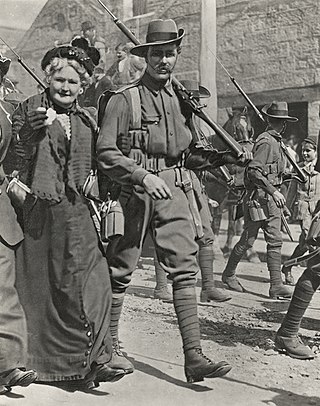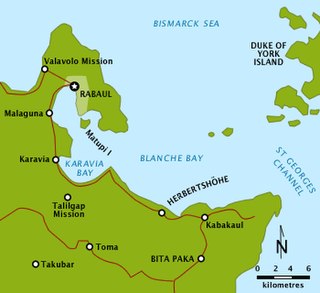Related Research Articles

Bougainville, officially the Autonomous Region of Bougainville, is an autonomous region in Papua New Guinea. The largest island is Bougainville Island, while the region also includes Buka Island and a number of outlying islands and atolls. The current capital is Buka, situated on Buka Island.

German New Guinea consisted of the northeastern part of the island of New Guinea and several nearby island groups and was the first part of the German colonial empire. The mainland part of the territory, called Kaiser-Wilhelmsland, became a German protectorate in 1884. Other island groups were added subsequently. The Bismarck Archipelago, and the North Solomon Islands were declared a German protectorate in 1885; in the same year the Marshall Islands were bought from Spain for $4.5 million by the Hispano-German Protocol of Rome; Nauru was annexed to the Marshall Islands protectorate in 1888, and finally the Caroline Islands, Palau, and the Mariana Islands were bought from Spain in 1899. German Samoa, though part of the German colonial empire, was not part of German New Guinea.

Kaiser-Wilhelmsland formed part of German New Guinea, the South Pacific protectorate of the German Empire. Named in honour of Wilhelm I, who reigned as German Emperor from 1871 to 1888, it included the northern part of present-day Papua New Guinea. From 1884 until 1920 the territory was a protectorate of the German Empire. Kaiser-Wilhelmsland, the Bismarck Archipelago, the northern Solomon Islands, the Caroline Islands, Palau, Nauru, the Northern Mariana Islands, and the Marshall Islands comprised German New Guinea.

The Australian Naval and Military Expeditionary Force (AN&MEF) was a small volunteer force of approximately 2,000 men, raised in Australia shortly after the outbreak of World War I to seize and destroy German wireless stations in German New Guinea in the south-west Pacific. The German wireless installations were ordered to be destroyed because they were used by Vizeadmiral Maximilian von Spee's East Asia Squadron of the Imperial German Navy, which threatened merchant shipping in the region. Following the capture of German possessions in the region, the AN&MEF provided occupation forces for the duration of the war. New Zealand provided a similar force for the occupation of German Samoa.

Morobe Province is a province on the northern coast of Papua New Guinea. The provincial capital and largest city is Lae. The province covers 33,705 km2, with a population of 674,810, and since the division of Southern Highlands Province in May 2012 it is the most populous province. It includes the Huon Peninsula, the Markham River, and delta, and coastal territories along the Huon Gulf. The province has nine administrative districts. At least 101 languages are spoken, including Kâte and Yabem language. English and Tok Pisin are common languages in the urban areas, and in some areas pidgin forms of German are mixed with the native language.

HMAS Warrego, named for the Warrego River, was a River-class torpedo-boat destroyer of the Royal Australian Navy (RAN). Ordered in 1909, construction of the destroyer started in England, but she was then broken down and reassembled at Cockatoo Island Dockyard in order for the Australian shipbuilding industry to gain experience in warship construction. Warrego was commissioned into the RAN in 1912, and spent her early career operating in Australian waters.

Asian and Pacific theatre of World War I consisted of various military engagements that took place on the Asian continent and on Pacific islands. They include naval battles, the Allied conquest of German colonial possessions in the Pacific Ocean and China, and an anti-Russian rebellion in Russian Turkestan and an Ottoman-supported rebellion in British Malaya. The most significant military action was the careful and well-executed Siege of Tsingtao in China, but smaller actions were also fought at Bita Paka and Toma in German New Guinea.
1914 in Australia was dominated by the outbreak of World War I. Andrew Fisher, who became Prime Minister a month after Australia entered the war vowed that Australia would "stand beside our own to help and defend Britain to the last man and the last shilling." In 1914, the Australian war effort was dominated by recruiting and equipping a force to fight overseas.

Although the military history of Oceania probably goes back thousands of years to the first human settlement in the region, little is known about war in Oceania until the arrival of Europeans. The introduction of firearms transformed conflict in the region; in some cases helping to unify regions and in others sparking large-scale tribal and civil wars. Force and the threat of force played a role in the annexation of most of Oceania to various European and American powers, but only in Australia and New Zealand did wars of conquest occur. Western Oceania was a major site of conflict in World War II as the Japanese Empire sought to expand southwards. Since 1945 the region has been mostly at peace, although Melanesia has suffered from Indonesian expansionism in some areas and civil wars and coups in others. The Australian Defence Force is by far the largest military force in Oceania.

The Battle of Bita Paka was fought south of Kabakaul, on the island of New Britain, and was a part of the invasion and subsequent occupation of German New Guinea by the Australian Naval and Military Expeditionary Force (AN&MEF) shortly after the outbreak of the First World War. Similar to New Zealand's operation against German Samoa in August, the main target of the operation was a strategically important wireless station—one of several used by the German East Asiatic Squadron—which the Australians believed to be located in the area. The powerful German naval fleet threatened British interests and its elimination was an early priority of the British and Australian governments during the war.

The siege of Toma was a bloodless action during the First World War on the island of New Pomerania between 14 and 17 September 1914 as part of the occupation of German New Guinea by the Australian Naval and Military Expeditionary Force (AN&MEF). Australian forces had been dispatched to seize and destroy German wireless stations in the south-west Pacific because they were used by the German East Asian Cruiser Squadron of Vice-Admiral Maximilian von Spee which threatened merchant shipping in the region. New Zealand provided a similar force for the occupation of German Samoa. Ultimately the German colonial government was forced to surrender after being surrounded, ending the last significant resistance in the territory.

Hermann Philipp Detzner was a German engineer and surveyor, who served as an officer in the German colonial security force (Schutztruppe) in Kamerun (Cameroon) and German New Guinea. He gained fame for evading capture after Australian troops invaded German New Guinea at the start of World War I.

Johann Flierl was a pioneer Lutheran missionary in New Guinea. He established mission schools and organised the construction of roads and communication between otherwise remote interior locations. Under his leadership, Lutheran evangelicalism flourished in New Guinea. He founded the Evangelical Lutheran Mission in the Sattelberg, and a string of filial stations on the northeastern coast of New Guinea including the Malahang Mission Station.
The Rabaul War Cemetery, established in 1945, is located near the site of the former Bita Paka wireless station south of the city of Rabaul, New Britain, in Papua New Guinea. The cemetery is managed by the Commonwealth War Graves Commission. The cemetery contains the Australian and Commonwealth graves of those killed during operations in New Britain and New Ireland during World War II, or who died while prisoners of war.

The Imperial Wireless Chain was a strategic international communications network of powerful long range radiotelegraphy stations, created by the British government to link the countries of the British Empire. The stations exchanged commercial and diplomatic text message traffic transmitted at high speed by Morse code using paper tape machines. Although the idea was conceived prior to World War I, the United Kingdom was the last of the world's great powers to implement an operational system. The first link in the chain, between Leafield in Oxfordshire and Cairo, Egypt, eventually opened on 24 April 1922, with the final link, between Australia and Canada, opening on 16 June 1928.

The Australian occupation of German New Guinea was the takeover of the Pacific colony of German New Guinea in September – November 1914 by an expeditionary force from Australia, called the Australian Naval and Military Expeditionary Force.

As the township of Lae, in Morobe Province, Papua New Guinea is a relatively new entity, the history of the Lae environs is much older.

The New Guinea Air Warning Wireless, also known as the "New Guinea Air Warning Wireless Company", "NGAWW", or "The Spotters", was a unique signals unit of the Australian Army formed in January 1942 in Port Moresby, Territory of Papua, during World War II, to provide early warning of Japanese air attack, and subsequently providing surveillance of shipping and ground-based troops. During the first month of operations 16 stations were established, with positions set up along the Papuan coast as well as in the mountains near Port Moresby. They often operated behind Japanese lines and were at risk of being captured by the Japanese due to the nature of their operations, while a number of outstations were over-run and the men manning them killed. By the end of 1942 the company was maintaining 61 operational stations and had a strength of 180 men.
Bitapaka Rural LLG is a local-level government (LLG) of East New Britain Province, Papua New Guinea.
References
- ↑ Rowland, Michael (2014-09-07). "World War I: Bita Paka and the day German New Guinea came under Australian control". ABC. ABC News. Retrieved 2014-09-18.
Coordinates: 4°24′15″S152°18′07″E / 4.40417°S 152.30194°E